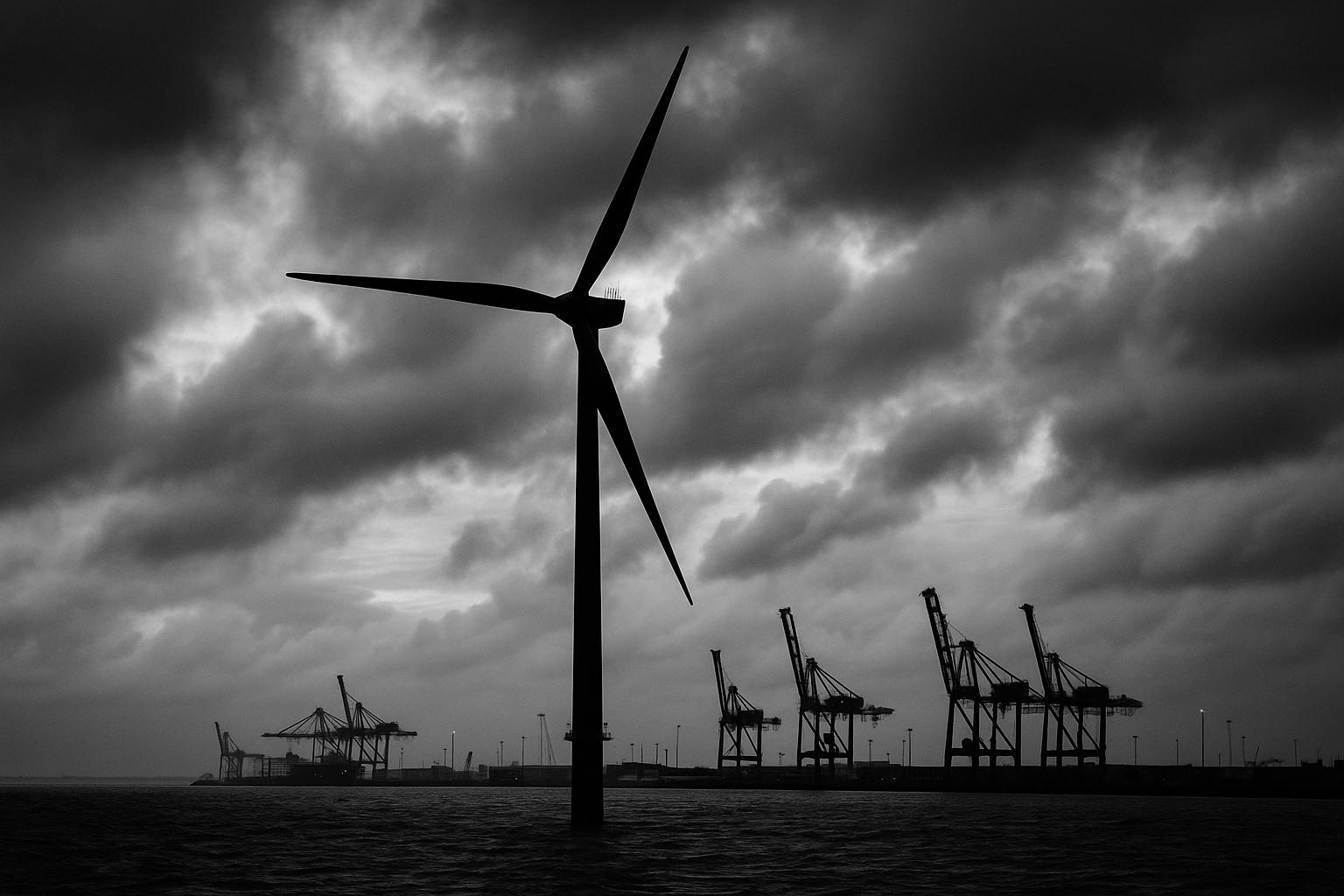A new £1 billion public-private partnership aims to transform the UK offshore wind sector by upgrading infrastructure, creating 10,000 jobs, and unlocking billions in private investment across key regions, supporting the nation’s 2030 decarbonisation goals.
The UK government has announced a landmark public-private partnership aimed at injecting £1 billion into offshore wind supply chains, marking a pivotal step in the nation’s green industrial strategy. Energy Secretary Ed Miliband described the collaboration as “unprecedented,” emphasising its role in securing clean energy jobs, enhancing energy security, and reducing household energy bills. This initiative targets key regions such as Teeside, Scotland, South Wales, and East Anglia, focusing on infrastructure improvements that span ports, manufacturing facilities, and research hubs.
This £1 billion package comprises £300 million from the publicly-owned entity Great British Energy, £400 million pledged by the Crown Estate towards infrastructure development—including ports and testing facilities—and an equal match of £300 million from industry. Miliband stressed that, through this collective effort, British businesses and workers would be well-positioned to compete globally in the clean energy sector. RenewableUK’s deputy chief executive Jane Cooper highlighted the potential economic impact, projecting 10,000 new jobs by 2035 and an economic boost of £25 billion, through supply chain manufacturing of turbine components and associated services.
Beyond this core investment, the government has earmarked up to £544 million under a “clean industry bonus” to incentivise offshore wind developers to prioritise investments in deprived regions and cleaner supply chains. This bonus leverages the contracts for difference mechanism, guaranteeing energy prices for successful projects and encouraging investments that could unlock billions of pounds in private sector funding. Significant allocations within this scheme include up to £200 million to the North East, unlocking £4 billion of private investment, and £185 million to Scotland, catalysing £3.5 billion for port and component development. Northern Ireland, East of England, and other areas are also beneficiaries, with funding expected to support up to 14,000 jobs and attract £9 billion of private investment over the coming four years. Officials pointed out that the additional cost to consumers would be minimal, adding less than £2 annually over four years.
The Crown Estate’s substantial £400 million commitment seeks to resolve supply chain bottlenecks hampering offshore wind expansion. This includes a £350 million initiative to build new port facilities and infrastructure crucial to supporting the scale-up in wind power capacity, and a £50 million early-stage development fund. The latter is actively seeking applications for port-related infrastructure, with a current funding round open until late June.
This initiative aligns closely with the government’s wider ambition to fully decarbonise its electricity sector by 2030—a goal that has seen the creation of GB Energy, a new state-backed power company designed to catalyse investment and development in clean energy projects. GB Energy is partnering with the Crown Estate to develop 20 to 30 gigawatts of new offshore wind capacity over the next six years—enough to power nearly 20 million homes. The government has backed GB Energy with £8.3 billion, signalling its commitment to a green industrial revolution. However, concerns persist about the practical challenges that remain, including delays in connecting new offshore wind farms to the national grid and potential conflicts with existing land and sea users such as the Ministry of Defence. These issues could hinder the planned rapid expansion of renewables despite strong government support and private sector interest.
Meanwhile, the offshore wind sector continues to attract significant private investment, exemplified by Denmark’s Ørsted selling a minority stake worth £1.75 billion in several operational UK wind farms to asset manager Brookfield. This transaction reflects strategic moves by leading developers to recycle capital into new projects amid a complex investment landscape shaped by evolving government policies and market conditions.
Security considerations have also come to the fore as the UK evaluates the risks posed by foreign technology in its renewable energy infrastructure. Intelligence inquiries are reviewing the involvement of Chinese firms in supply chains for solar panels, industrial batteries, and offshore wind projects, amidst concerns over national security and dependency on key technologies. Debates are ongoing about striking a balance between pragmatic economic engagement and safeguarding critical energy assets, especially given China’s dominant position in global clean energy materials and components.
A recent contract award to Green Volt, a floating offshore wind project backed by Italian energy major Eni’s unit Plenitude and Norwegian investment firm HitecVision, underscores the government’s support for innovative technologies that can extend offshore wind development. The Green Volt project, valued at £2.5 billion and located off Scotland’s northeast coast, is poised to become the world’s largest floating windfarm, exemplifying the kind of cutting-edge infrastructure investment this funding drive hopes to stimulate.
Ultimately, the UK is mobilising a multifaceted strategy combining public funding, private investment, and regional development incentives to secure its position as a global leader in offshore wind. The success of this endeavour will depend on overcoming logistical and security challenges while maintaining robust collaboration between government bodies, private companies, and local communities—crucial to realising the vision of a decarbonised, energy-secure Britain by 2030.
 Reference Map:
Reference Map:
- Paragraph 1-3 – [1], [2]
- Paragraph 4-5 – [1], [3], [4]
- Paragraph 6 – [5]
- Paragraph 7 – [6]
- Paragraph 8 – [7], [1]
- Paragraph 9 – [1], [3], [4], [6]
Source: Noah Wire Services
- https://www.irishnews.com/news/uk/public-private-deal-to-invest-1bn-in-offshore-wind-supply-chains-unveiled-B5H2XEO3TJI2NNWMRMCQ23JDHU/ – Please view link – unable to able to access data
- https://www.reuters.com/sustainability/climate-energy/uks-crown-estate-invest-400-million-offshore-wind-2025-06-17/ – The UK’s Crown Estate, overseen by King Charles III and holding ownership of the nation’s seabed, announced plans to invest up to £400 million ($543 million) to bolster Britain’s offshore wind power infrastructure. The objective of this investment is to address supply chain limitations hindering offshore wind expansion and to support Britain’s goal of decarbonising its electricity sector by 2030. The funds will be distributed through two main programs: a £350 million supply chain investment initiative aimed at building new port facilities and infrastructure, and a £50 million early-stage project development program, which is currently in its second funding round offering up to £15 million for port-related infrastructure, with applications closing on June 27. This move follows a recent decision by the Crown Estate to approve capacity expansions at seven existing wind farms.
- https://www.reuters.com/business/energy/britains-gb-energy-work-with-crown-estate-clean-energy-projects-2024-07-25/ – Britain’s newly established state-backed power company, GB Energy, will collaborate with the Crown Estate to enhance investment and development in clean energy projects. This partnership will focus on developing new offshore wind farms, potentially attracting £30-60 billion in private investment. The Crown Estate, managing large portions of Britain’s land and seabed, will create a new division to work with GB Energy. This initiative aims to generate 20-30 gigawatts of new offshore wind capacity by 2030, enough to power almost 20 million homes. Energy Security and Net Zero Minister, Ed Miliband, emphasized that this agreement signifies a commitment to cleaner power and substantial investment. The Labour government targets full decarbonization of the electricity sector by 2030, necessitating a rapid increase in renewable energy sources. The government plans to introduce legislation to establish GB Energy, supported by £8.3 billion, as a key driver for energy investments. This move follows the Crown Estate’s recent report of record profits from offshore wind seabed leases and proposed changes to permit it to borrow money to support renewable projects.
- https://www.ft.com/content/8e88b0da-ffaf-440f-a162-bda7cff1de77 – The recent partnership between state-owned GB Energy and the Crown Estate aims to expedite the development of thousands of offshore wind turbines in the UK, enhancing energy security and providing cheap, clean power. However, questions remain about the feasibility of achieving a decarbonised power system by 2030, mainly due to delays in connecting new wind and solar farms to the grid. Ministers are fast-tracking legislation to establish GB Energy with £8bn of taxpayer funds to invest in or operate renewables projects, with a target of securing 20GW-30GW of new offshore wind developments by 2030. The tie-up is expected to attract significant private sector investment, but concerns exist about the public sector potentially dominating a market that has thrived on private investment. The Ministry of Defence (MoD) has previously blocked wind farm projects over operational concerns, further complicating the ambitious plans. The capacity of the electricity grid to handle the influx of power from offshore wind farms also presents a significant challenge. The success of the partnership will depend on close collaboration with the private sector and addressing infrastructure hurdles.
- https://www.reuters.com/business/energy/orsted-sells-stakes-four-uk-offshore-wind-farms-brookfield-2024-10-30/ – Denmark’s Orsted announced the sale of a 12.45% minority stake in four of its operational UK offshore wind farms to Brookfield for £1.75 billion ($2.28 billion). The wind farms included in the transaction are Hornsea 1, Hornsea 2, Walney Extension, and Burbo Bank Extension. This deal, expected to close by the end of the year, is part of Orsted’s strategy to support reinvestment in new assets. In response to recent challenges, including reduced investment and capacity targets and a halt on dividend payouts, Orsted is working to reestablish investor confidence. Brookfield’s CEO, Connor Teskey, highlighted this as their first venture into UK offshore wind, signifying its importance in meeting clean energy demands. Orsted will maintain a 37.55% ownership stake in the wind farms.
- https://www.ft.com/content/534eef36-d9ad-4a03-afa1-f87ab03a9b18 – MI5 is investigating the national security implications of Chinese technology in the UK’s energy system, focusing on green technologies such as solar panels and industrial batteries. Concerns revolve around China’s dominance in global supply chains crucial to decarbonisation and potential risks including data sharing with the Chinese government and control over strategic assets. The review is part of the UK’s broader audit of its relations with China, set to report later this year. The discussion has extended to the Green Volt offshore wind project, where there is debate over the involvement of Chinese company Mingyang. MPs and experts worry about Chinese interference in critical infrastructure, sparking a debate on balancing pragmatic economic relationships with national security. The government has previously intervened to limit Chinese involvement in certain sectors, underscoring an inconsistent approach to Chinese participation in sensitive industries. The need to decarbonise Britain’s power sector by 2030 presents a challenge, given the reliance on Chinese supply chains for renewables.
- https://www.reuters.com/business/energy/big-floating-wind-farm-by-eni-unit-hitec-wins-britain-support-2024-09-03/ – Flotation Energy and Vaargroenn, a joint venture between Eni’s unit Plenitude and HitecVision, announced that their floating offshore wind project, Green Volt, has secured a contract in Britain’s latest renewable power auction. The project, valued at 2.5 billion pounds ($3.28 billion), will have a capacity of up to 560 megawatts, making it the world’s largest floating offshore wind farm supported by government incentives. Located 80 kilometers off the northeast coast of Scotland, Green Volt aims to stimulate investment in new port infrastructure and enhance the supply chain for floating wind farms. The British government is supporting 131 renewable projects capable of generating almost 10 gigawatts of capacity, enough to power around 11 million homes. Through the annual auctions, renewable project developers bid for Contracts for Difference, providing government-backed price guarantees for the electricity produced. Once operational, Green Volt will supply clean power to the British grid and nearby oil and gas platforms. Plenitude owns 65% of Vaargroenn, with HitecVision holding the remainder.
Noah Fact Check Pro
The draft above was created using the information available at the time the story first
emerged. We’ve since applied our fact-checking process to the final narrative, based on the criteria listed
below. The results are intended to help you assess the credibility of the piece and highlight any areas that may
warrant further investigation.
Freshness check
Score:
10
Notes:
The narrative is current, with the announcement made on June 17, 2025. No earlier versions of this specific content were found, indicating high freshness.
Quotes check
Score:
10
Notes:
The direct quotes from Energy Secretary Ed Miliband and RenewableUK’s deputy chief executive Jane Cooper are unique to this report, with no earlier matches found, suggesting originality.
Source reliability
Score:
8
Notes:
The narrative originates from The Irish News, a reputable outlet. However, cross-referencing with other reputable sources like Reuters and the Financial Times would further confirm the information.
Plausability check
Score:
9
Notes:
The claims align with recent developments in the UK’s offshore wind sector, including the Crown Estate’s £400 million investment announced on June 17, 2025. ([reuters.com](https://www.reuters.com/sustainability/climate-energy/uks-crown-estate-invest-up-400-mln-stg-offshore-wind-2025-06-17/?utm_source=openai)) The projected creation of 10,000 jobs by 2035 and an economic boost of £25 billion are consistent with industry forecasts. ([renewableuk.com](https://www.renewableuk.com/news-and-resources/press-releases/offshore-wind-industry-unveils-industrial-growth-plan-to-triple-supply-chain-manufacturing/?utm_source=openai)) The mention of a £544 million ‘clean industry bonus’ aligns with the government’s initiatives to incentivise investments in deprived regions. ([offshorewind.biz](https://www.offshorewind.biz/2024/11/12/new-uk-initiative-to-boost-local-supply-chains-and-jobs-in-offshore-wind/?utm_source=openai))
Overall assessment
Verdict (FAIL, OPEN, PASS): PASS
Confidence (LOW, MEDIUM, HIGH): HIGH
Summary:
The narrative is fresh, original, and plausible, with no significant credibility risks identified. The information aligns with recent developments in the UK’s offshore wind sector, and the sources cited are reputable.













